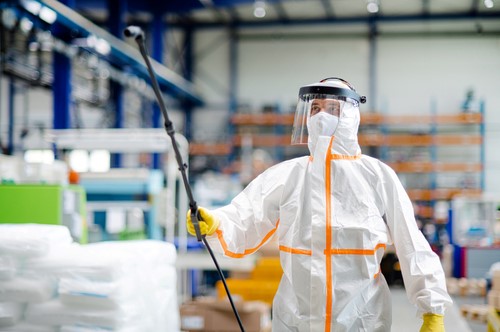5 ways Covid-19 has already changed American manufacturing
Editor’s note: This is the first in a series of three guest posts by Kate Began of Polycase.
The Covid-19 outbreak has changed the global business landscape in ways that would have seemed unbelievable just a few months ago. Businesses have been forced to reevaluate their approach to everything–from sourcing to operations. The manufacturing industry has seen particularly high levels of disruptions as plants are temporarily shut down and supply chains are disrupted.
A few months into the pandemic, trends have begun to emerge that allow the business community to begin to analyze Covid-19’s impact on American manufacturing. While supply has been constricted on everything from electronics enclosures to pharmaceuticals, demand has mutated in unpredictable ways, and businesses are scrambling to find new strategies for addressing these challenges.
These five aspects have already created major change in the manufacturing economy, and manufacturers will need to face them head-on to create a plan for surviving the continuing challenges of the post-pandemic business landscape.
1. Quarantines and shutdowns have caused some major hits to the bottom line for the American manufacturing industry.
Many U.S. manufacturers were forced to shut down as a result of the “stay-at-home” orders that their states imposed in March and April of 2020. Those that weren’t required to shut down often had to produce at reduced capacity, thanks to lower demand in many industries (as we’ll discuss later).
The result has been dramatic: an estimated 25 percent decrease in yearly profit predictions for the American manufacturing industry. While it’s true that manufacturers in some sectors, such as CPGs and medical equipment, have seen enormous spikes in demand, the overall financial picture for the manufacturing sector (particularly heavy industry) remains disturbing.
Having taken such a painful hit to the bottom line, many manufacturing businesses find themselves limping into Q3 and in need of a new plan for finishing out the year. Easy answers will be in short supply, but manufacturers will need to take decisive action to prevent a bad situation from becoming worse.
2. The devastating impact of lax safety procedures has become apparent.
American manufacturing businesses have to face the facts: During a pandemic, inaction is deadly. We’ve seen uncontrolled outbreaks sweep through meat-packing facilities across the nation, killing dozens and sickening thousands more. While it’s true that meat-packing plants are uniquely vulnerable to the spread of respiratory diseases, the risks apply to any facility in which workers are in close proximity to one another and/or share equipment.
Manufacturers owe it to their employees, their customers, and the world at large to ensure that their facilities don’t contribute to the spread of coronavirus. More than ever, practicing good workplace hygiene has become a matter of life and death. Businesses must be sure to follow the CDC’s guidelines for businesses and employers, and they must strictly enforce compliance among employees.
Steps as simple as requiring masks at work can significantly reduce the chances of disease spread. However, in order to truly reach the level of a responsible corporate citizen, manufacturers must commit to substantial reconfiguration of their processes to institute social distancing in the workplace.
3. Manufacturing supply chains have seen major disruptions.
The globe-crossing supply chains that characterize 21st-century commerce have had their reliability severely tested by the pandemic. China, in particular, has experienced major logistics problems, such as closed ports and grounded flights. With so many of the world’s manufacturing supply chains running through China, many businesses have had to find creative ways to keep their operations running.
Business experts say that this global supply chain chaos has been a major learning experience for manufacturers, who were often caught without sufficient options when their Chinese supply chains began to collapse in February and March. Going forward, these businesses will have to put a new focus on diversifying their supply chains to increase their resilience to globally disruptive events such as pandemics. Those low-priced Chinese components may do great things for the bottom line, but you can’t capture any of those benefits if you can’t get the materials in the first place.
4. Demand has plummeted in some sectors (and exploded in others).
With the Covid-19 pandemic has come an economic contraction that has suddenly plunged the U.S. economy into a recession. As a result, demand has massively decreased in many key American manufacturing sectors. Industry reports demonstrate that demand for everything from heavy equipment to electronics to metal fabrication continues to experience painfully intense contractions.
The silver lining for some manufacturers is that demand has actually increased rapidly in some sectors. Food, beverage, and other essential household CPG manufacturers have all seen massive surges in demand, as have medical supply manufacturers. The demand surge has even reached some unexpected corners such as the DIY home products industry as bored, homebound Americans take on home improvement projects.
These shifts in demand have produced some fascinating examples of the versatility and agility of leading American manufacturers. Top consumer fashion brands have begun production of surgical masks and gowns, while industrial manufacturers like 3M have used their state-of-the-art fabrication facilities to produce ventilators and other key healthcare equipment.
5. Cash flow will be a major priority moving forward.
In a turbulent economy, many manufacturers are reevaluating their cash flow strategies and prioritizing liquidity. By maintaining increased cash reserve levels, manufacturers can prepare themselves better to deal with the constantly shifting nature of the Covid-19 crisis.
Bolstering cash flow effectively requires applying a finance-driven mindset across all levels and departments of a manufacturing organization. The day-to-day practice of supply chain operations tends to be conceptually grounded in inventory management and customer relationships. While these are critical facets that can’t be sacrificed, supply chain operators need to become more practiced in thinking like a CFO and seeing the financial framework that underpins logistics decisions.
However, it’s important to remember that financial concerns should never take priority over the safety of employees and customers. The ultimate goal is to create a system of operations where both employment and physical well-being are safe and well-protected.
The novel coronavirus has given the U.S. economy a massive dose of that most dangerous economic toxin: uncertainty. For manufacturers to continue to thrive and compete, they must turn that uncertainty into innovation and seize the new opportunities that this rapidly changing economy presents to them.
Kate Began serves as the Sales and Marketing Manager for Polycase. She oversees the customer service representatives, assists with product development, and leads the marketing efforts from the Avon, Ohio headquarters. Kate is also an avid Cleveland Indians fan.
Read more:
Stop hibernating: You’re missing out on company blog benefits
When short on time, updating old blog posts for SEO makes a lot of sense
Key step to moving beyond survival mode: Revising B2B buyer personas




